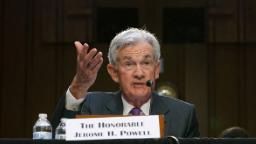

New York
CNN
—
The US economy has been remarkably resilient, defying a year’s-worth of recession calls. From the labor market to consumer spending to inflation, key readings on the economy have been running hot.
Incredibly, despite a war in Ukraine, labor shortages in the US, biting inflation for consumers, a looming debt-ceiling showdown and an aggressive eight interest rate hikes in a year, America’s economic engine is humming along. Although that might sound like good news for Main Street, it’s a problem for the Federal Reserve.
“The latest economic data have come in stronger than expected which suggests that the ultimate level of interest rates is likely to be higher than previously anticipated,” Federal Reserve Chairman Jerome Powell told lawmakers Tuesday. “If the totality of the data were to indicate that faster tightening is warranted, we would be prepared to increase the pace of rate hikes.”
Translation: The Fed needs to keep cranking up interest rates to cool off the economy. Although that could help tame inflation, hiking rates even more aggressively could slow the economy so much that people lose their jobs, the housing market slows and loan rates surge for millions of Americans.
After a spate of stronger-than-expected economic data, buckle up for an intense few weeks of Fed guessing, especially surrounding the tight labor market. Despite headlines of layoffs in tech and finance, the job market has been so far impervious to the Fed’s tightening. There are nearly two job openings for each job seeker and the jobless rate at 3.4% is the lowest in 54 years. The strong labor market means workers are enjoying the best wage growth in years. but that wage growth feeds into inflation.
“Let’s not question that it’s unequivocally good to see people with jobs and income,” ADP chief economist Nela Richardson told me on CNN’s Early Start. “What’s bad is that it’s coming at the cost of inflation.”
It’s one reason the Fed is penciling in a higher jobless rate in the quarters ahead, raising the ire of progressives like Senator Elizabeth Warren who accuses the Fed of trying to weaken the job market to achieve its inflation goals. By the Fed’s own estimate, higher rates could lead to unemployment in the mid 4% range, which would mean 2 million more people out of work.
It led to a testy exchange at the Senate Banking Committee hearing this week.
“If you could speak directly to the 2 million hardworking people who have decent jobs today, who you’re planning to get fired over the next year– what would you say to them?” Warren asked Powell.
“I would explain to them that inflation is very high.” Powell responded. “And it’s hurting the working people of this country badly. All of them, not just 2 million of them. But all of them are suffering from high inflation. And we are taking the only measures we have to bring inflation down.”
Essentially, the Fed thinks the needs of the many (keeping inflation in check for hundreds of millions of working people) outweigh the needs of the relatively few (the single-digit millions who may lose their jobs as the central bank purposefully slows the economy.)
The next two weeks will serve as a crucial test on how much more medicine the economy needs. Friday’s jobs report, Tuesday’s CPI inflation report, Wednesday’s PPI inflation and retail sales reports, Thursday’s housing report, next Friday’s consumer sentiment report and the following Tuesday’s existing home sales will give the Fed a lot to think about ahead of its rate decision on March 22.
